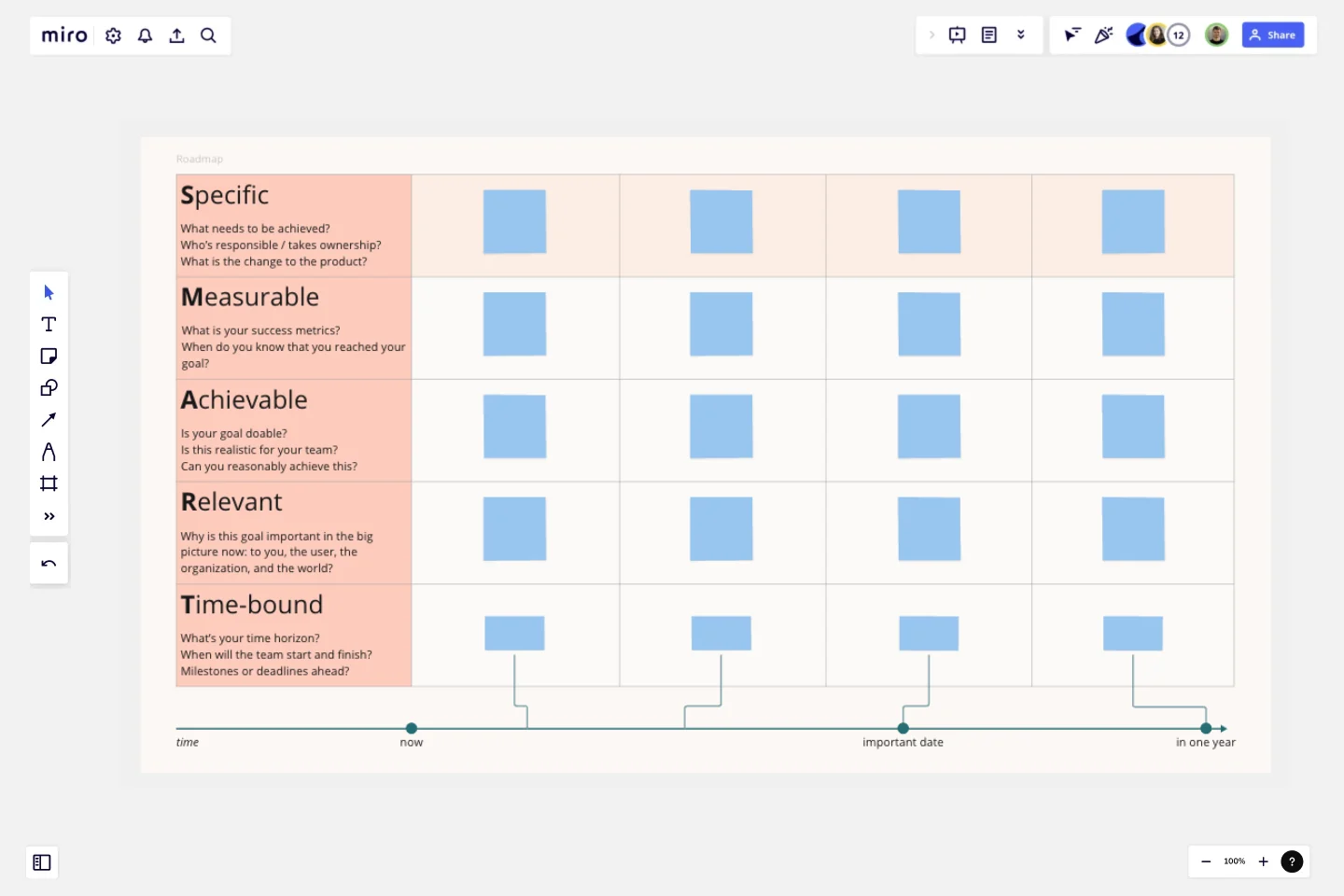SMART Agile Product Roadmap
A product roadmap is a plan that shows how the product shall develop in a set timeframe.
It helps you express where you want to take your product and why it's worth investing in. An agile product roadmap also helps with learning and making changes. One way to achieve these goals is by using a goal-oriented roadmap, which focuses on goals instead of many features.
Advantage of an agile goal-oriented roadmap
Goal-oriented roadmap change the discussion from arguing about tiny features to agreeing on common goals. This helps reduce conflict between those who see roadmap features as commitments and agile teams who only commit for a short period of time to align the roadmap on a high, goal based, level.Formulating these goals the SMART way helps to establish criteria for effective goal-setting and objective development. SMART is an acronym used as a mnemonic device.
How to set a SMART goal
Specific:
What needs to be achieved?
Who’s responsible / takes ownership?
What is the change to the product?
Measurable:
What is your success metrics?
When do you know that you reached your goal?
Achievable:
Is your goal doable?
Is this realistic for your team?
Can you reasonably achieve this?
Relevant:
Why is this goal important in the big picture now: to you, the user, the organization, and the world?
Time-bound:
What’s your time horizon?
When will the team start and finish?
Milestones or deadlines ahead?
This template was created by Jan Schneider.
Get started with this template right now.
[Triple Diamond] Project Map
Works best for:
Roadmap, Mapping, Planning
The [Triple Diamond] Project Map template provides a comprehensive framework for managing project initiatives from inception to delivery. By guiding teams through the stages of discovery, definition, and delivery, this template ensures alignment with stakeholder expectations and project objectives. With a focus on user-centric design and iterative development, teams can deliver high-quality solutions that meet user needs and drive business value.
Product Roadmap Template
Works best for:
Product Management, Roadmaps
Product roadmaps help communicate the vision and progress of what’s coming next for your product. It’s an important asset for aligning teams and valuable stakeholders – including executives, engineering, marketing, customer success, and sales – around your strategy and priorities. Product roadmapping can inform future project management, describe new features and product goals, and spell out the lifecycle of a new product. While product roadmaps are customizable, most contain information about the products you’re building, when you’re building them, and the people involved at each stage.
Async Roadmap Sharing
Works best for:
Roadmaps, Planning, Mapping
Async Roadmap Sharing template facilitates asynchronous collaboration on roadmap planning and execution. By providing a centralized platform for sharing updates, feedback, and insights, teams can ensure alignment and transparency across distributed teams. This template promotes flexibility and inclusivity, allowing team members to contribute to roadmap discussions at their own pace and asynchronously across different time zones.
Multiple-Product Roadmap
Works best for:
Planning, Mapping
The Multiple Product Roadmap template empowers product managers to visualize and manage multiple product initiatives effectively. By providing a centralized view of project timelines, dependencies, and milestones, this template fosters alignment and transparency across teams. With sections for prioritizing initiatives, tracking progress, and communicating updates, it enables teams to coordinate efforts and drive collective success. This template serves as a strategic tool for planning and executing product roadmaps that align with organizational goals and drive business growth.
Agile Transition Plan Template
Works best for:
Agile Methodology, Agile Workflows
An Agile transformation roadmap can help you, your team, and your organization transition from rigid compliance-heavy methods to the more flexible Agile way of doing things incrementally. From requirements to integrations to security, you can map out your organization's moving parts as “swim lanes” that you can then update regularly. Use your roadmap as a way to tell the story of how you see your product growing over a period of time. Get buy-in without overselling and keep your roadmap simple, viable and measurable. By using an Agile transformation roadmap, you can avoid getting bogged down in details and instead invest in big-picture strategic thinking.
Agile Product Roadmap (Now, Next, Later)
Works best for:
Product Roadmap
Stay ahead in your product development with the Agile Product Roadmap Now Next Later template. This tool allows you to plan and prioritize features and improvements dynamically, ensuring your product evolves with market needs. Visualize short-term, mid-term, and long-term goals to keep your team focused and aligned. Perfect for product managers and agile teams aiming to deliver continuous value.
